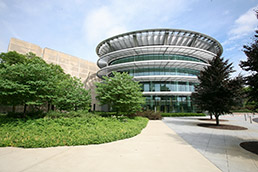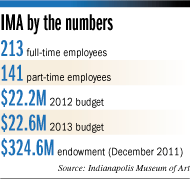Subscriber Benefit
As a subscriber you can listen to articles at work, in the car, or while you work out. Subscribe NowAfter three years of shrinking budgets, Indianapolis Museum of Art leaders are ready to leave the lean times behind.
“The current budget is certainly sustainable, but we do intend to grow the business,” said Dan Cantor, treasurer and chairman of the finance committee of the board of governors.
The IMA’s endowment, which has covered close to 70 percent of operating expenses, is on the rebound and reached $324 million at the end of last year.
 The IMA cut its operating budget in the wake of the 2008 financial crisis, but hopes to grow its programs again. (IBJ file photo)
The IMA cut its operating budget in the wake of the 2008 financial crisis, but hopes to grow its programs again. (IBJ file photo)That’s still below the pre-recession height of $393 million, but much healthier than the lows of early 2009—in February that year, it dropped to $267 million.
While investment losses will play into the museum’s budget for another year, the board is looking to continue the momentum of its attention-grabbing projects like 100 Acres: The Virginia B. Fairbanks Art and Nature Park.
The IMA might name a new CEO, who would be the key to launching an endowment-building campaign, as early as this summer, Deputy Director for Public Affairs Katie Zarich said.
Maxwell Anderson, the Melvin and Bren Simon director and CEO who departed for the Dallas Museum of Art in December, began strategic planning in 2010 with an eye toward an endowment drive. Cantor said it’s too early to talk about a dollar target.
Market performance isn’t the only factor holding down the endowment. The museum, while making serious cuts to its operating budget, continued to spend endowment funds at a rate that outstripped investment returns.
Cantor said a plan to lower the spending rate over five years has been put off because the investment losses coincided with a difficult fundraising environment. In other words, the IMA would have been facing Greek-style austerity.
“We didn’t want to fundamentally change the institution,” Cantor said
The spending rate is calculated as all expenses, including restricted funds, against an average of the endowment value over 12 quarters.
The museum was spending as much as 8 percent before the recession. While that rate has dropped, it’s still above the long-term average investment returns of 5 percent to 6 percent that most financial advisers project.
With the money-losing quarters of 2009 still in the calculation, the projected spending rate for 2013 is 7.1 percent, Cantor said. From there, the board would like to lower spending to 5.5 percent by fiscal year 2018, Cantor said. “We feel this time frame is doable and prudent.”
Initiatives like 100 Acres, which opened in 2010, and the acquisition of the Miller House and Garden in Columbus are supported by dedicated funds. But the museum’s core budget took a hit after the 2008 financial crisis.
The IMA had a round of layoffs in early 2009, followed by furloughs and across-the-board budget cuts. Operating expenses fell from more than $28 million in 2008 to $20.8 million in the fiscal year ended June 30, 2011.
 Total expenses in the 2011 fiscal year actually rose $3.6 million, to $32.6 million, because of increased depreciation, debt service and special projects, such as representing the United States at the Venice Biennale. Special projects are primarily supported by restricted grants and donations.
Total expenses in the 2011 fiscal year actually rose $3.6 million, to $32.6 million, because of increased depreciation, debt service and special projects, such as representing the United States at the Venice Biennale. Special projects are primarily supported by restricted grants and donations.
The operating budget rose to $22.2 million in the current year, and it’s projected at $22.6 million for 2013, Cantor said. Basic personnel costs drove most of the recent budget increases, he said. The IMA has 213 full-time and 141 part-time employees.
Cantor said a number of positions throughout the museum have gone unfilled. Other areas, such as a new conservation science lab, are ripe for growth, Zarich said.
That growth will hinge on the endowment’s continued rebound, plus a ramp up in fundraising. The endowment is a long way from the depths of early 2009, but growth in donations has been slow to come.
The museum expects to raise $3.4 million for general operations next year, which is in line with what it brought in each of the prior two years, Zarich said.
Chief Development Officer Cynthia Rallis, hired in late 2010, is laying the groundwork for the endowment campaign, Cantor said. More recently, the museum hired Andra Walters, former vice president of development with Indiana Landmarks, to work with people who give $1,500 to $25,000 a year.
“We haven’t had the staff attention devoted to that group,” Zarich said. “We do think there’s good potential for growth there.”
Arts fundraisers across the country appear to be faring better than their peers in other charity sectors. Giving to arts and humanities rose 5.7 percent in 2010, according to the latest Giving USA study, which looks at itemized donations reported to the Internal Revenue Service.
Some art museums already have knocked down major gifts and closed out huge capital campaigns. Endowment-building is a common theme.
The Chrysler Museum of Art in Norfolk, Va., has raised $41.5 million to endow certain programs and operations, noted Peter Hoskow, managing director of Midwest operations for New York-based fundraising consultants CCS.
The Portland Art Museum recently announced a $2 million pledge to endow a curator of modern and contemporary art.
“Typically, endowment funds are among the most difficult to raise,” Hoskow said. “Discerning donors are often more inclined to support capital projects and annual needs.”
Hoskow thinks a museum can overcome the bias toward bricks and mortar by talking up its heritage and value to the community.
“Endowment campaigns usually target the most generous, most affluent museum donors,” he said. Those donors understand the importance of a “hearty and healthy” endowment for future growth and security, should another revenue source fall short, Hoskow said.
The IMA’s endowment was at one point among the 10 largest in the country. Museum officials said they believe it’s still in the top 20, but it may have been surpassed by others that recently ended campaigns.
The Peabody Essex Museum in Salem, Mass., recently raised $550 million for an expansion and to grow its endowment to $630 million, the Boston Globe reported. The campaign, which started in 2006, vaulted the small museum into the endowment top 10, the Globe said.•
Please enable JavaScript to view this content.
